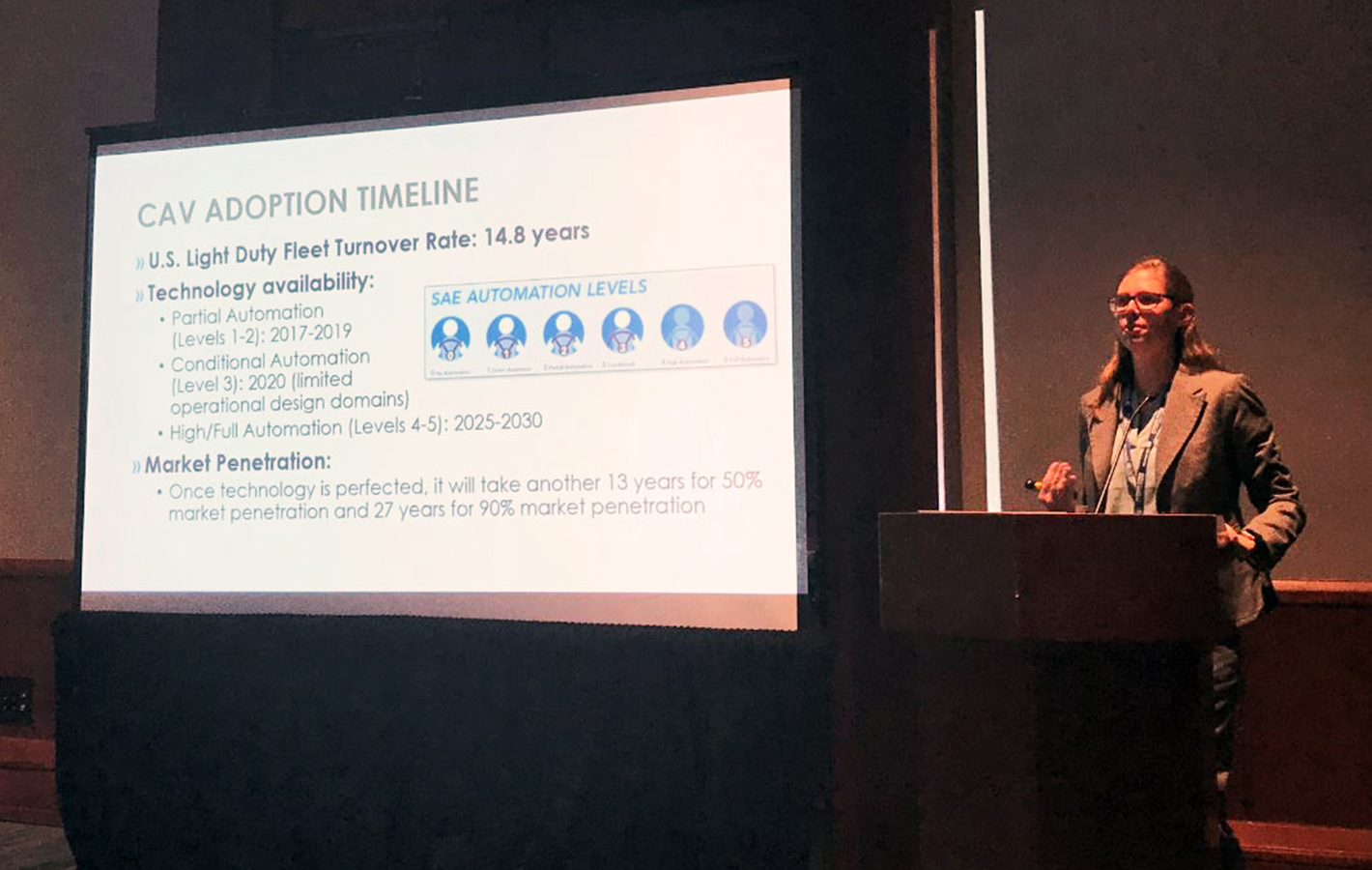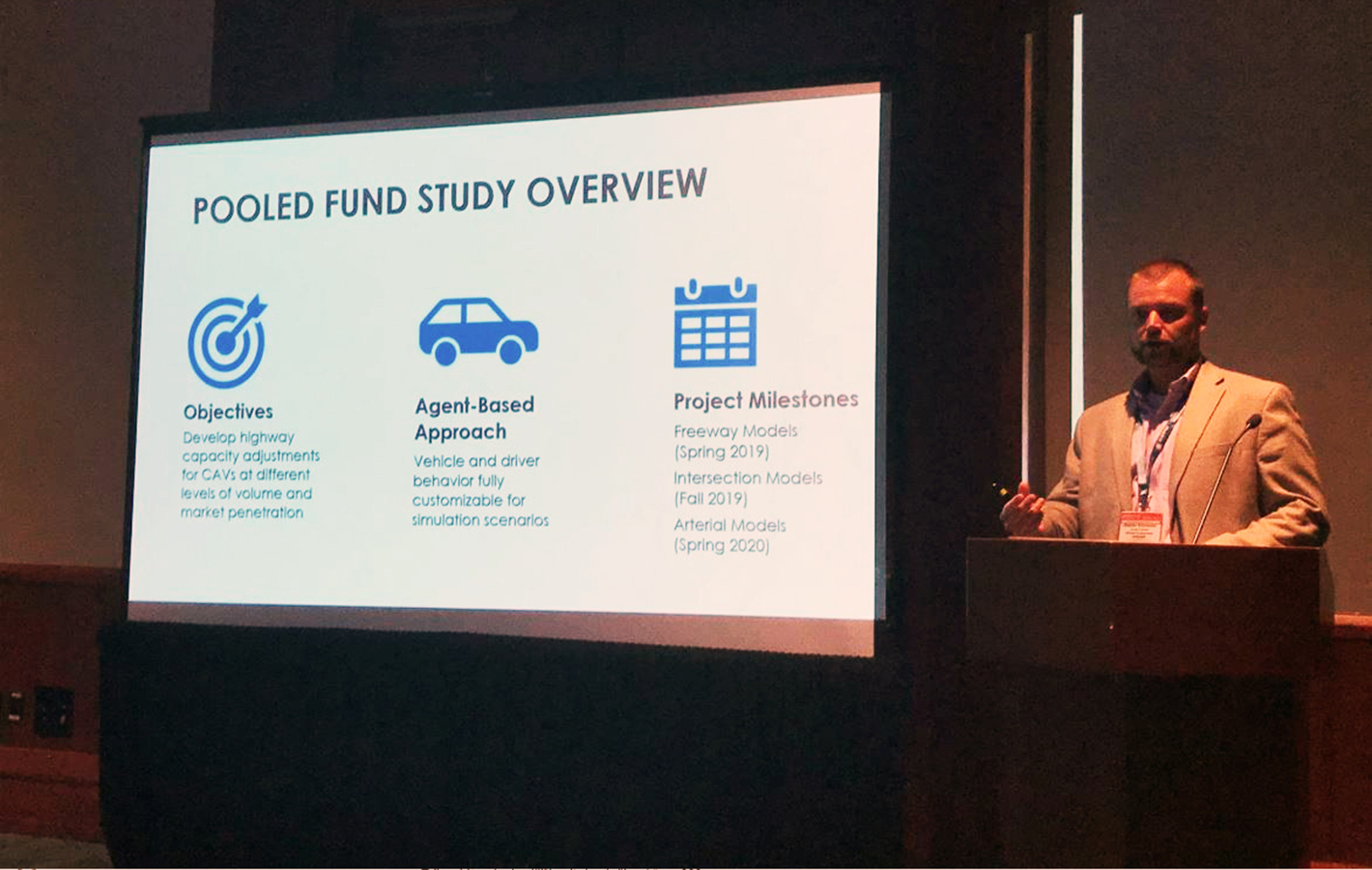August 21, 2019
From July 15-18, 2019 in Orlando, Florida, leaders in all branches of transportation technology came together to share new research, make connections, and discuss the future of automated vehicles. This was the first year the Automated Vehicles Symposium was held in Orlando, and the move from San Francisco to a city across the country known by many for tourism than for tech brought a change in feel to the event.
Several Kittelson staff members attended AVS 2019 to catch the latest conversations, and to present research we are leading through a pooled fund study from 14 DOTs about capacity impacts of connected and automated vehicles (CAVs). We enjoyed attending sessions and getting the chance to ride in a few automated vehicles.


Abby (left) and Bastian (right) presenting on how capacity predictions will change as CAVs increase market penetration. Can we all agree that photos in dark conference rooms with big screens are a struggle?
One element we appreciated about the event was the use of Chatham House Rules. According to Chatham House rules, attendees are free to share what was said in discussion, but not the name or affiliation of the speaker. Because an automated vehicle future is still marked by unknowns, we felt this was an effective way to remove barriers to speaking openly and asking important questions to facilitate conversation. It also means that no names are assigned to the takeaways shared in this article.
There was much to talk about at AVS 2019. Here are seven takeaways we found particularly meaningful.
1. CAVs in urban environments are not going to be a capacity improvement.
Auto manufacturers are concerned primarily with safety (as they should be), followed by comfort and convenience. Capacity impacts are not at the top of their priority list. Automated vehicles are programmed to err on the side of caution, which means that without connectivity, automated driving systems may be more conservative that human drivers.
This conservative behavior could actually reduce capacity in urban driving unless vehicles are communicating with each other. While several researchers (including our own study) are arriving at potential increases in capacity for freeway driving and dedicated CAV facilities, complex and multimodal urban system are less likely to see much change.
Adaptive cruise control is an example of an automated driving system that could decrease capacity if the vehicles are not connected. A vehicle’s movements will be more conservative when the speed changes just from sensing changes in the speed of the vehicle in front of it. The more connected a vehicle is to more vehicles on the road, the more insight it will have, and the more efficient it will be with space.
We presented our initial capacity impact findings in the session “Planning-Level Capacity Adjustments for Connected and Automated Vehicles: The Future is Now.” The pooled fund study we’re leading will ultimately bring the Highway Capacity Manual into the age of connected and automated vehicles (CAVs). Our results were consistent with the other related research projects that studied capacity impacts of CAVs on freeways.
2.The definition of safety as “free of unreasonable risk.”
While every state is trying to quantify the safety benefits of automated vehicles compared to human drivers, the reality is it’s impossible to define a safe, attentive, and sober driver purely by numbers. One expert at AVS was asked to define safety, and he put it this way: “Safety is being free of unreasonable risk.” It’s not conceivable that automated vehicles will never crash; if we’re waiting for that day to come, we’ll never get them on the road. It is conceivable that auto manufacturers can remove unreasonable risk by equipping vehicles with automated driving systems and by protecting human life in the ways we can program and predict.
3. Engagement and education will help us avoid misinformation.
Because not all risk can be eliminated, engagement with fellow transportation professionals and with the public, as well as effective education around operating automated vehicles, is needed to avoid misinformation and an over-reliance on autopilot technology. Tesla’s fatal crashes are a sobering testament to this. Automated vehicle technology brings fascinating capabilities, but there are limitations. Today, drivers still need to follow safety precautions such as wearing seatbelts and keeping watch behind the wheel so they can take over when needed.
4. Operational design is conditions-based and not geographic.
Automated driving systems (ADS) include a range of performance, defined by the operational design domain (ODD) set by the manufacturer. Discussions at AVS confirmed that ODD is more strongly influenced by conditions than by geographic area. For example, if intense weather conditions pick up within an approved geographic area, the driving system will transition from automated to human-operated, or the vehicle will slow to a safe stop. This is not dependent on where the vehicle is located geographically.
5. Sharing information > sharing data.
Big data has been an important topic for some time now. And while transparent data is essential for making good decisions, it’s also practical to ask the question: does your agency have the staff on hand to process a data dump? How much utility are you getting out of raw data? When seeking data, do you know what you want to learn from it? It’s a collective effort to plan for automated vehicles on our roads, and we should focus on sharing knowledge and information with one another, not just data. As many agencies are still trying to figure out how to process and use 5-minute resolution vehicle probe data, the potential for large volumes of sub-second trajectory data and high resolution signal controller data can be ominous.
6. Automated vehicle safety preparedness goes beyond the vehicle.
Planning for CAV deployments – such as automated shuttles – includes thinking through emergency procedures beyond vehicle malfunctions. One AVS attendee shared about a recent university automated shuttle deployment that needed to plan emergency procedures in the event of an active shooter. In this case, the vehicle operator would take over remote control of the automated shuttle, drive it to the closest building, and open the doors into the building so passengers could run inside without being exposed. Deployments should also take natural disasters into account in their emergency plans and should call for engagement with non-engineering groups such as law enforcement and first responders. Many attendees and speakers further emphasized the importance of infrastructure investments, and addressing the challenges of helping agencies plan (and build for) a CAV future.
7. Interdisciplinary partnerships are critical.
Emergency plans are just one activity that make the case for interdisciplinary partnerships. One of the benefits of the AVS conference is the variety of groups it brings together. The automated vehicle field encompasses many smaller fields; this was clear from the number of sessions and companies represented. The success of this setup, however, relies on intentional dialogue and communication between groups.
As transportation planners and engineers, we need to understand challenges facing auto manufacturers and vendors, and we want them to understand the work we’re doing to create environments in which automated vehicles can be safe and successful. We encourage those who attend AVS (including ourselves) in the future to choose more sessions outside of their wheelhouse to better understand the bigger picture of where our industry is heading.
Whether you attended AVS 2019 or tuned in from afar, we hope you found these takeaways insightful. If you were in Orlando with us, we’d love to hear what stood out to you from the event! Reach out to Abby or Bastian to tell us your experience at AVS or start a dialogue about any of the topics we mentioned here.
